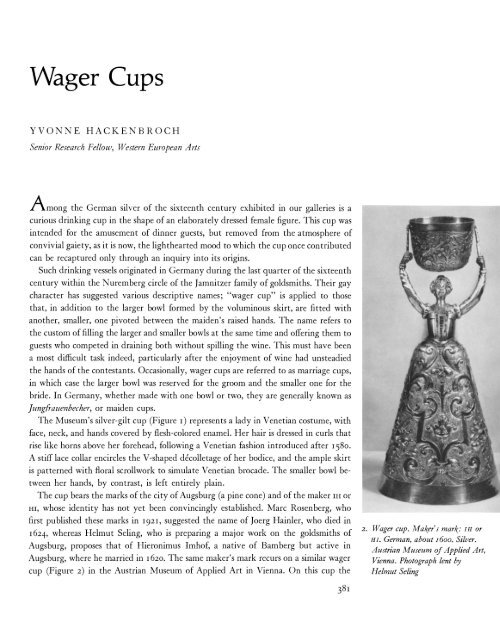Wager Cups - Metropolitan Museum of Art
Wager Cups - Metropolitan Museum of Art
Wager Cups - Metropolitan Museum of Art
Create successful ePaper yourself
Turn your PDF publications into a flip-book with our unique Google optimized e-Paper software.
<strong>Wager</strong> <strong>Cups</strong><br />
YVONNE HACKENBROCH<br />
Senior Research Fellow, Western European <strong>Art</strong>s<br />
Among the German silver <strong>of</strong> the sixteenth century exhibited in our galleries is a<br />
curious drinking cup in the shape <strong>of</strong> an elaborately dressed female figure. This cup was<br />
intended for the amusement <strong>of</strong> dinner guests, but removed from the atmosphere <strong>of</strong><br />
convivial gaiety, as it is now, the lighthearted mood to which the cup once contributed<br />
can be recaptured only through an inquiry into its origins.<br />
Such drinking vessels originated in Germany during the last quarter <strong>of</strong> the sixteenth<br />
century within the Nuremberg circle <strong>of</strong> the Jamnitzer family <strong>of</strong> goldsmiths. Their gay<br />
character has suggested various descriptive names; "wager cup" is applied to those<br />
that, in addition to the larger bowl formed by the voluminous skirt, are fitted with<br />
another, smaller, one pivoted between the maiden's raised hands. The name refers to<br />
the custom <strong>of</strong> filling the larger and smaller bowls at the same time and <strong>of</strong>fering them to<br />
guests who competed in draining both without spilling the wine. This must have been<br />
a most difficult task indeed, particularly after the enjoyment <strong>of</strong> wine had unsteadied<br />
the hands <strong>of</strong> the contestants. Occasionally, wager cups are referred to as marriage cups,<br />
in which case the larger bowl was reserved for the groom and the smaller one for the<br />
bride. In Germany, whether made with one bowl or two, they are generally known as<br />
Jungfrauenbecher, or maiden cups.<br />
The <strong>Museum</strong>'s silver-gilt cup (Figure i) represents a lady in Venetian costume, with<br />
face, neck, and hands covered by flesh-colored enamel. Her hair is dressed in curls that<br />
rise like horns above her forehead, following a Venetian fashion introduced after i580.<br />
A stiff lace collar encircles the V-shaped decolletage <strong>of</strong> her bodice, and the ample skirt<br />
is patterned with floral scrollwork to simulate Venetian brocade. The smaller bowl between<br />
her hands, by contrast, is left entirely plain.<br />
The cup bears the marks <strong>of</strong> the city <strong>of</strong> Augsburg (a pine cone) and <strong>of</strong> the maker IH or<br />
HI, whose identity has not yet been convincingly established. Marc Rosenberg, who<br />
first published these marks in i92I, suggested the name <strong>of</strong> Joerg Hainler, who died in<br />
I624, whereas Helmut Seling, who is preparing a major work on the goldsmiths <strong>of</strong><br />
Augsburg, proposes that <strong>of</strong> Hieronimus Imh<strong>of</strong>, a native <strong>of</strong> Bamberg but active in<br />
Augsburg, where he married in I 620. The same maker's mark recurs on a similar wager<br />
cup (Figure 2) in the Austrian <strong>Museum</strong> <strong>of</strong> Applied <strong>Art</strong> in Vienna. On this cup the<br />
38I<br />
2. <strong>Wager</strong> cup. Maker's mark: IH or<br />
HI. German, about i6oo. Silver.<br />
Austrian <strong>Museum</strong> <strong>of</strong> Applied <strong>Art</strong>,<br />
Vienna. Photograph lent by<br />
Helmut Seling

















